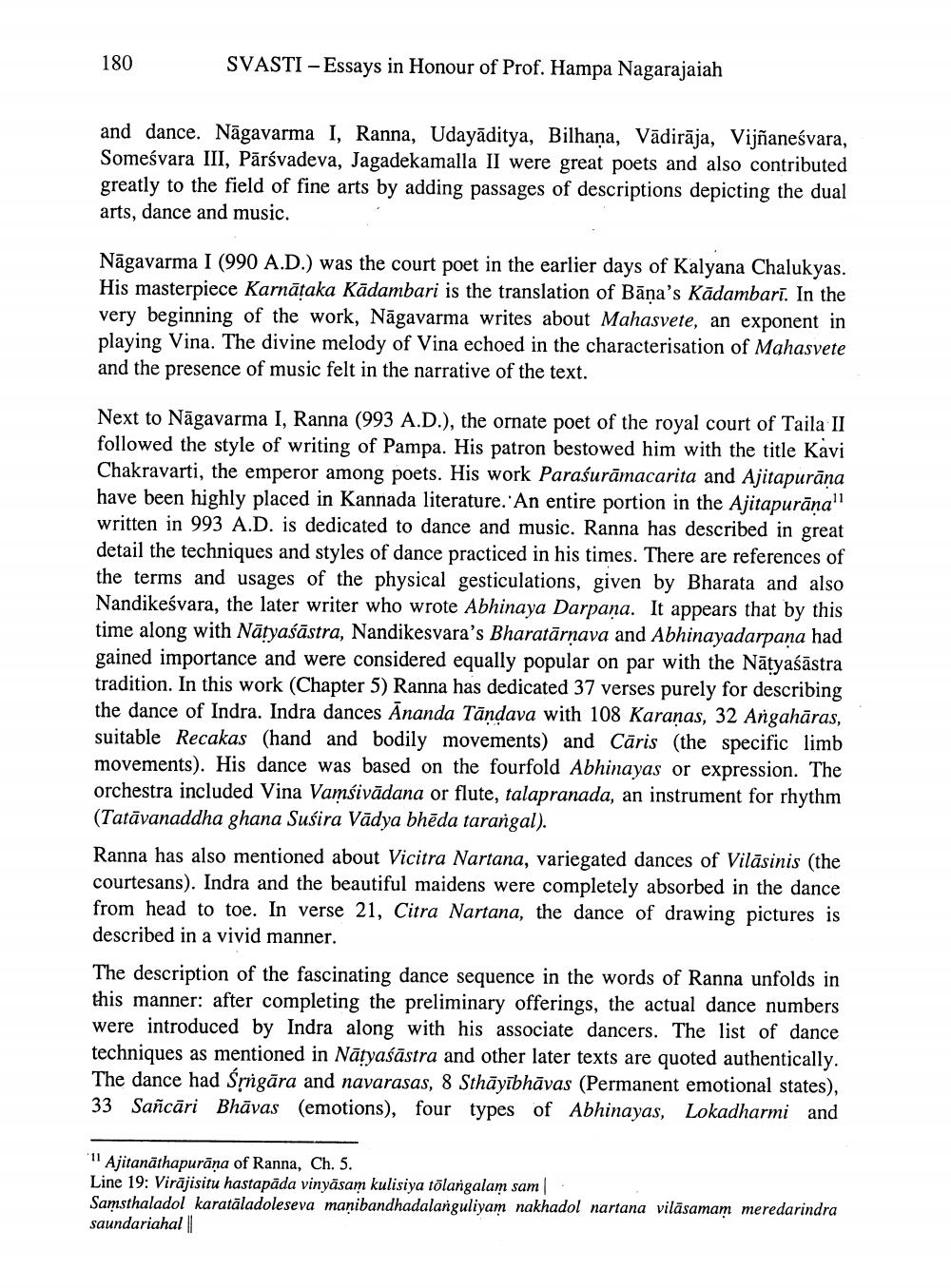________________
180
SVASTI - Essays in Honour of Prof. Hampa Nagarajaiah
and dance. Nagavarma I, Ranna, Udayaditya, Bilhana, Vädiräja, Vijñanesvara, Somesvara III, Pārśvadeva, Jagadekamalla II were great poets and also contributed greatly to the field of fine arts by adding passages of descriptions depicting the dual arts, dance and music.
Nagavarma I (990 A.D.) was the court poet in the earlier days of Kalyana Chalukyas. His masterpiece Karnataka Kādambari is the translation of Bana's Kadambari. In the very beginning of the work, Nagavarma writes about Mahasvete, an exponent in playing Vina. The divine melody of Vina echoed in the characterisation of Mahasvete and the presence of music felt in the narrative of the text.
Next to Nagavarma I, Ranna (993 A.D.), the ornate poet of the royal court of Taila II followed the style of writing of Pampa. His patron bestowed him with the title Kavi Chakravarti, the emperor among poets. His work Parasuramacarita and Ajitapurana have been highly placed in Kannada literature. An entire portion in the Ajitapuraṇa" written in 993 A.D. is dedicated to dance and music. Ranna has described in great detail the techniques and styles of dance practiced in his times. There are references of the terms and usages of the physical gesticulations, given by Bharata and also Nandikeśvara, the later writer who wrote Abhinaya Darpana. It appears that by this time along with Naryaśästra, Nandikesvara's Bharatärnava and Abhinayadarpana had gained importance and were considered equally popular on par with the Natyaśästra tradition. In this work (Chapter 5) Ranna has dedicated 37 verses purely for describing the dance of Indra. Indra dances Ananda Tandava with 108 Karanas, 32 Angahāras, suitable Recakas (hand and bodily movements) and Caris (the specific limb movements). His dance was based on the fourfold Abhinayas or expression. The orchestra included Vina Vamsivädana or flute, talapranada, an instrument for rhythm (Tatavanaddha ghana Susira Vädya bhēda tarangal).
Ranna has also mentioned about Vicitra Nartana, variegated dances of Viläsinis (the courtesans). Indra and the beautiful maidens were completely absorbed in the dance from head to toe. In verse 21, Citra Nartana, the dance of drawing pictures is described in a vivid manner.
The description of the fascinating dance sequence in the words of Ranna unfolds in this manner: after completing the preliminary offerings, the actual dance numbers were introduced by Indra along with his associate dancers. The list of dance. techniques as mentioned in Natyaśästra and other later texts are quoted authentically. The dance had Śpigāra and navarasas, 8 Sthayibhāvas (Permanent emotional states), 33 Sañcari Bhāvas (emotions), four types of Abhinayas, Lokadharmi and
"Ajitanathapuraṇa of Ranna, Ch. 5.
Line 19: Virajisitu hastapāda vinyasam kulisiya tölangalam sam
Samsthaladol karataladoleseva manibandhadalanguliyam nakhadol nartana vilāsamam meredarindra saundariahal




